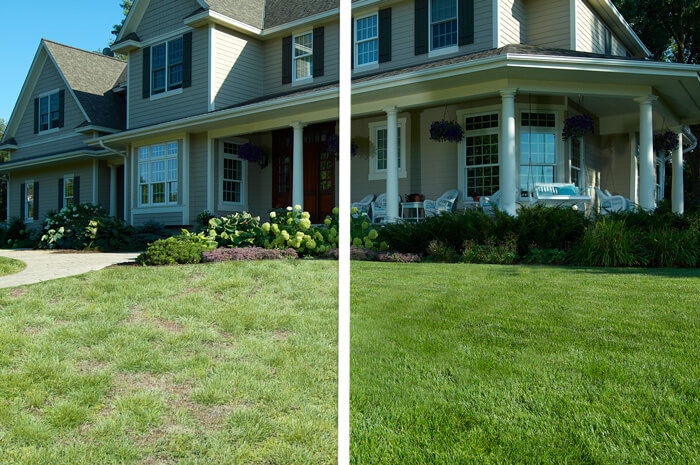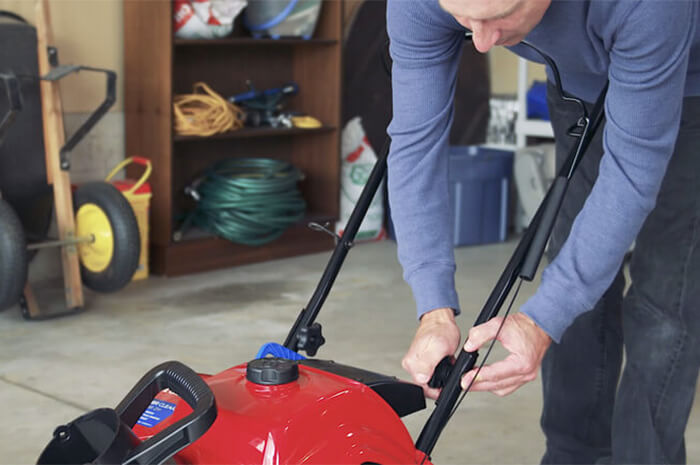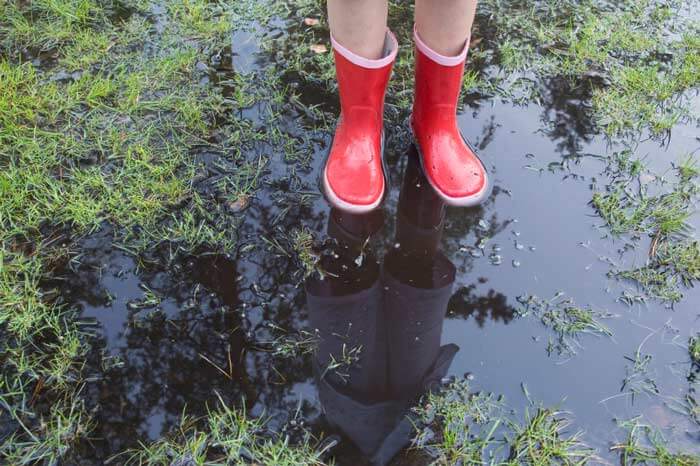
How Do I Turn My Bad Lawn into a Good One?
Bare spots. Dead grass. Yard full of weeds. Do you ever want to clear your lawn and start over, but not sure what to do? It’s all enough to make you give up hope on ever having a beautiful green yard. But, with a little DIY work and a few growing seasons, you can renovate your lawn into that plot of healthy green grass you’ve always wanted.
Ready to learn how to fix a weedy lawn and get your green grass back? Let’s get started.
Step 1: Get to the Root of the Matter
Start your lawn restoration by dethatching your yard. Thatch is that thick layer of grass clippings and other organic material at the base of your grass. Too much starves your grass of oxygen and nutrients. Shovel out a triangular plug of grass that’s a few inches deep. If the thatch layer is up to an inch thick when you press on it, it’s time to dethatch. It’s best to do this in spring or fall.
Step 2: Be On the Straight and Level
All those bumps and divots in your yard can make you mad — or even twist your ankle. Luckily, they’re both quick fixes during a lawn restoration.
For Depressions:
For small divots, throw on a little topsoil and a layer of compost. Use a landscaping rake to make sure it’s smooth and level with the area around it. For larger depressed areas, remove the sod and fill the hole with a mixture of soil, compost, humus, and fertilizer. Then, replace the sod and press it down. Remember to water any repaired areas.
For Bumps:
Remove a 2’x2’ section of sod and the excess dirt below it. Throw in some compost and soil, soak it with a hose, and cover it back up with the removed sod. Place some of your remaining dirt around the cut edges to help blend in the patch.
Step 3: Build Good Chemistry
Want your yard to love you back? You need good chemistry, so test your soil’s PH levels. If your soil’s pH levels are too high or too low, many nutrients cannot get to the grass. There are a few ways to test at home, but the easiest are either a pH soil tester you can purchase at any home and garden center or hire a professional lawn care service.
Step 4: Feed It
Fertilizer does wonders for starving yards. To restore your lawn to its healthy best, use a slow-release fertilizer and be careful about how much you use. Using too much could lead to nitrogen burning and disease, or fertilizer leaching into storm drains.
If you tested your soil, make sure you apply the fertilizer recommended by the results. If you didn’t test your soil, apply a slow-release fertilizer with a nitrogen-phosphorus-potassium ratio of 3-1-1.
Seeding your yard as part of your lawn renovation? Add fertilizer a week prior and water it into the soil.
Step 5: Keep Your Invisible Friends Happy
Your yard is a living, breathing community filled with billions of microbes and microscopic organisms per handful of soil. Keep them happy and well fed on soil that has 2–5% organic material, and they’ll help restore your lawn and keep it green and healthy.
Step 6: Air it Out
Some lawns are so starved for attention and oxygen, you just need to literally poke them to speed up the renovation process. By using a core aerator on your yard, you create space in your soil that allows grass roots to grow deeper, and receive more fertilizer and organic matter they need to thrive. Read our article on the best time to aerate your yard.
Step 7: Spread Some Grass Seed
Use your hands or a broadcast spreader to spread grass seed throughout your lawn. Want more power? A slit-seeder cuts little slits in your yard and plants the grass seed automatically.
Before sowing the grass seed, dethatch your yard to expose the soil by a ½ inch, and soak your yard. Start sowing at the edge of your area. Divide the remaining seed and apply half while walking in one direction, and the rest while walking in another. Lightly cover the seeded area with compost and topsoil.
When you overseed depends on where you live.
Northern Climates:
Overseed in late summer or early fall to help young grass germinate, establish strong roots, and store food needed for spring.
Southern Climates:
Overseed in the early summer to help the grass grow strong roots and store nutrients right before fall.
Step 8: Show Some Love
Restoring a lawn isn’t a one-off project; your yard needs appropriate care. To speed up germination, mist your yard for 5 to 10 minutes in the morning and afternoon after you overseed, and twice a day thereafter.
Your grass should be about two-inches tall in four to six weeks. At this time, you can return to a normal watering schedule, and even maybe a second dose of fertilizer—check the instructions first! You can mow it once it reaches three to four inches tall. Make sure your mower blade is sharp. A dull mower blade will only rip up your young grass — and we’re right back where we began.
You deserve a great-looking green lawn, and in eight simple steps, you can restore yours in no time.



